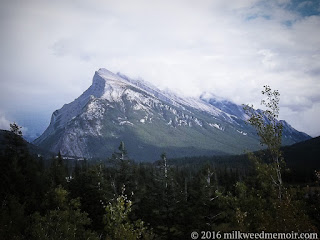Three days after rainy Yoho National Park, Glacier National Park (Canada) was just as rainy. I basically just drove through on the Trans-Canadian Highway through Rogers Pass. Again, pretty but not photogenic.
One cool thing was that the highway is roofed in places to protect drivers from avalanches!
BTW, I technically went through Mount Revelstoke National Park after this, but as I could see even less – nothing but the road in front of me, really – I didn't take photos and don't even count it as a visit.
Thursday, September 8, 2016
Monday, September 5, 2016
Narao Peak, Yoho National Park, British Columbia, Canada
I didn't get to see much of Narao Peak at the Continental Divide or the rest of Yoho National Park, thanks to early autumn rains. It was pretty but not photogenic.
Sunday, September 4, 2016
Rundle Mountain, Banff National Park, Alberta, Canada
 |
| Click for larger, clearer image |
Kootenay River, Kootenay National Park, British Columbia, Canada
 |
| Click for larger, clearer image |
- There is little sediment or chemical leaching from the hard Precambrian rocks that comprise the Canadian Rockies
- The water hasn't filtered through much forest on its way off the peaks, therefore gaining little sediment or dissolved tannins
- Colloidal calcium carbonate (CaCO3) in the water has optical properties that enhance the tendency of deeper water to reflect a blue / cyan / turquoise color.
Subscribe to:
Comments (Atom)

